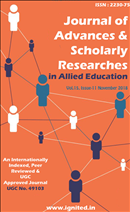Study on Trade Environment Growth Linkage Model
The Relationship between Trade, Environment, and Globalization
Keywords:
trade environment, growth linkage model, classic approaches, environment-generated externality, Pigou, government agency, polluter, damages, marginal cost of abatement, marginal benefit, tax levied, noncompliance, penalty, globalization, coercive powers, nation states, trans-boundary, global warming, climate change, local environmental problems, international dimensionsAbstract
These two classic approaches differ in terms of the mechanism for solving the problem of environment-generated 2 externality. Pigou emphasizes the need for a government agency to identify the polluter, assess the damages caused, estimate the marginal cost of abatement and the marginal benefit of such abatement. The tax levied is appropriate when the marginal cost of abatement equals the marginal benefit from it. Under noncompliance, the government agency is empowered to impose penalty. In this Pigouvian schema the state is looked upon as the all – powerful protector of the environment. But, issues relating to the interface between trade and environment seem to suggest that globalization leads to a clear debilitation of the coercive powers of the nation states. First, problems relating to the environment are often trans-boundary (e.g., global warming, climate change etc.). Second, even local environmental problems may have significant international dimensions. This happens when economic decisions shift the source of externality from one country to another.Published
2018-11-01
How to Cite
[1]
“Study on Trade Environment Growth Linkage Model: The Relationship between Trade, Environment, and Globalization”, JASRAE, vol. 15, no. 11, pp. 679–683, Nov. 2018, Accessed: Jul. 08, 2024. [Online]. Available: https://ignited.in/jasrae/article/view/9133
Issue
Section
Articles
How to Cite
[1]
“Study on Trade Environment Growth Linkage Model: The Relationship between Trade, Environment, and Globalization”, JASRAE, vol. 15, no. 11, pp. 679–683, Nov. 2018, Accessed: Jul. 08, 2024. [Online]. Available: https://ignited.in/jasrae/article/view/9133








